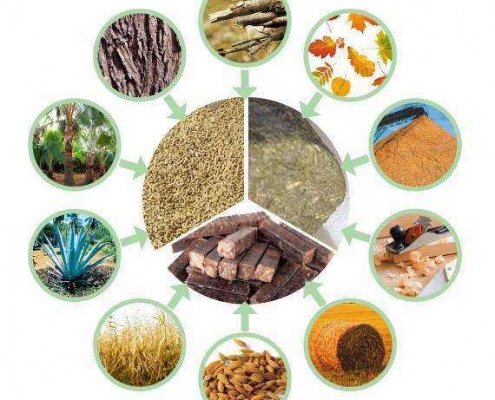Biomass is the organic matter contained in all living things. In a broad sense, biomass includes all plants, microorganisms, and the animals that feed on them and the waste they produce. The narrow concept of biomass refers to substances such as lignocellulosic materials such as straw and trees other than grain and fruits during agricultural and forestry production, wastes from agricultural products processing industry, agricultural and forestry waste, and poultry manure and waste during livestock production .
Biomass is characterized by renewable, low pollution and widespread distribution. Biomass energy is the form of energy that solar energy stores in biomass in the form of chemical energy, that is, energy that uses biomass as a carrier. It is derived directly or indirectly from photosynthesis of green plants and can be converted into conventional solid, liquid and gaseous fuels. The characteristics of biomass energy are renewable, clean, low-carbon, alternative advantages, and abundant raw materials. Therefore, biomass energy is also called biomass clean energy.
There are four main sources of biomass clean energy:
1. Straw
Some of the fixed solar energy of crops through photosynthesis will remain in the straw and cannot be used by humans. According to statistics, the total straw yield of the nine major crops in China in 2007 was 7.04 × 108t, and the total capacity was 3.55 × 108t standard coal. The top three are corn, wheat and rice. At present, with the exception of a small amount of straw used for traditional fuels, gaskets, livestock feeding, and some for composting, most of it is burned as waste. When the straw is burned on the wood stove, the conversion efficiency is only 10% ~ 20%. Nowadays, the amount of waste straw in many areas has increased year by year, and it has accounted for more than 60% of the straw output. It is imperative to accelerate the conversion and utilization of high-quality straw.

2. Firewood
Fuelwood biomass includes forest harvesting residues, wood processing residues, clear forest afforestation pruning residues, and fuelwood forests that specifically provide fuelwood. The sources of biomass resource use in many countries are mainly forestry wastes and charcoal forests. Formulating long-term forestry planning and rational and planned deforestation and afforestation will help resolve supply-demand contradictions and ecological problems.
3. Poultry manure
Poultry manure is also an important biomass energy. It can be directly burned to supply heat energy after drying, and can also be mixed with straw as raw material for fermentation of biogas. In 2007, the actual amount of livestock and poultry manure was 1.247x109t, and the developable amount was 8.84x108t. The main sources were cattle, pigs, and chickens. The amount of manure can be converted to 1.098x108t standard coal.
4. Urban waste and industrial organic waste
Urban waste is a mixture of household waste, commercial and service waste, and a small amount of construction waste. The composition is relatively complex. Its direct combustion can generate thermal energy, or it can be made into fuel by pyrolysis treatment. The national solid waste removal and transportation volume is 1.52 × 108t (about 30% containing organic waste), and the available rate is 10%. The available resource amount is 1.6 × 107t, and the standard coal is 2.5 × x106t.
Organic wastewater and municipal wastewater from the food / agricultural processing industry are important sources of organic pollutants, as well as biomass raw material resources. According to data estimates, organic waste produced and processed by Chinese agricultural products can produce 5.0x1010m3 biogas, which is equivalent to 3.5 × 107t standard coal production capacity. In 2007, the total annual discharge of industrial and urban sewage in China was 5.57 × x1010t, and the total amount of chemical oxygen demand (COD) contained was close to 2.0 × 107t, and biogas could be produced at 1.10x1010m3.


